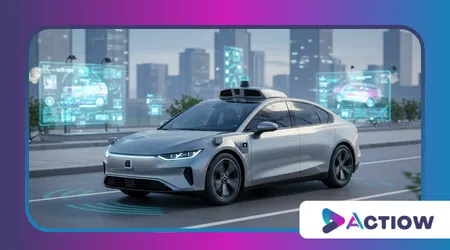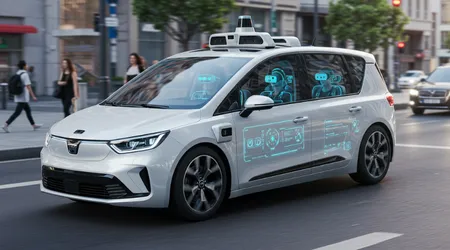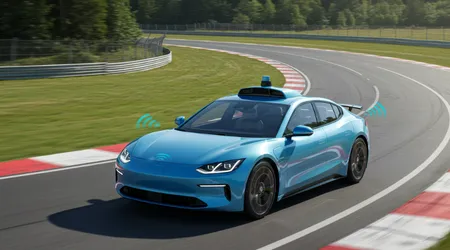Self-Driving Cars: The Future of Transportation?

Anúncios
Self-driving cars spark endless debates about innovation, safety, and the very essence of driving, blending cutting-edge tech with human curiosity.
Imagine a world where your vehicle whisks you to work while you sip coffee, or a late-night ride home requires zero effort, just trust in algorithms.
Transportation’s future teeters on this edge exciting yet uncertain, promising efficiency but shadowed by questions.
Anúncios
As a car and motorcycle enthusiast, I’ve spent years dissecting engines, horsepower, and now, autonomy’s rise.
This isn’t just about machines; it’s about redefining freedom, responsibility, and how we move through life.
The road to this point has been wild, paved with breakthroughs and skepticism alike.
Companies like Tesla, Waymo, and newcomers push boundaries, blending AI with automotive grit.
Meanwhile, regular folks drivers, bikers, even chemists tinkering with fuel wonder what’s next. Will autonomy liberate us from traffic jams, or tangle us in ethical knots?
Buckle up, because we’re diving deep into this revolution, exploring its gears, its glitches, and whether it’s truly the destination we’re headed for.
Curiosity drives this journey, much like it fuels a chemist mixing compounds for the perfect reaction. Self-driving tech isn’t science fiction anymore it’s here, humming on highways, sparking headlines.
But beyond the hype, what’s the real story?
Let’s peel back the hood, sift through the data, and argue the stakes, from dazzling possibilities to potholes we can’t ignore.
By the end, you’ll see why this matters not just for gearheads, but for anyone who moves.
The Tech Behind the Wheel
Picture a car that sees, thinks, and reacts faster than any human, powered by cameras, radar, and LIDAR weaving a digital web.
Artificial intelligence crunches data in milliseconds, steering through rain or rush hour without breaking a sweat.
Tesla’s Full Self-Driving system, for instance, evolves with every mile, learning from real-world chaos. It’s not just mechanics it’s a brain on wheels, redefining what “driving” means.
++ The Most Iconic Classic Cars of All Time
This isn’t magic; it’s engineering married to code, a symphony of sensors and software humming under sleek hoods.
Waymo’s fleet, clocking millions of miles by 2025, proves it works, navigating cities with eerie precision. Yet, complexity breeds fragility power outages or hacked systems could stall progress.
Enthusiasts like me marvel at the ingenuity, but even a flawless machine can’t escape human-made messes.

Safety: Promise or Peril?
Autonomy whispers a bold promise: fewer crashes, less carnage, a world where human error doesn’t end lives.
The National Highway Traffic Safety Administration reported 42,795 U.S. road deaths in 2022 many preventable with sharper reflexes, like those of self-driving cars.
Machines don’t drink, doze, or text, offering a cold, calculated edge over our flawed instincts. It’s tempting to cheer for this savior.
Also read: How to Choose the Best Car for Your Needs
Flip the coin, though, and shadows emerge, chillingly real. Autonomous systems falter in freak storms or when pedestrians dart unpredictably situations humans often intuit.
A 2024 Tesla incident, misjudging a cyclist, reignited doubts, proving tech isn’t infallible.
Safety’s a tug-of-war between data-driven hope and the messy, unpredictable dance of life, leaving us to weigh the odds.
The Freedom Factor
Nothing beats the thrill of gripping a steering wheel or throttling a motorcycle, wind whipping past as you command the road.
Self-driving cars threaten that visceral joy, turning drivers into passengers, passive in their own journeys.
For gearheads, it’s a gut punch autonomy might streamline travel, but at what cost to the soul of motion?
Read more: Top 10 Most Anticipated Cars of 2025: New Releases in the Market
Yet, flip that lens, and freedom shifts shape, unshackling us from gridlock or parking woes. Imagine reclaiming hours lost to commutes, productivity soaring as cars glide autonomously.
For the disabled or elderly, it’s a lifeline, not a loss mobility reborn. Freedom’s not dead; it’s just wearing a new face, one we’re still learning to recognize.
Chemists might see it as a catalyst, speeding up life’s reactions without altering its core. The trade-off fascinates losing control to gain time, swapping adrenaline for ease.
My biker heart resists, but my practical side nods, torn between romance and reason. Which freedom wins?
That’s the million-mile question.
Environmental Impact: Green or Gimmick?
Transportation guzzles fuel and spews emissions, a puzzle chemists have wrestled with for decades could autonomy crack it?
Self-driving cars optimize routes, cut idling, and pair with electric power, slashing carbon footprints.
A 2024 UC Davis study found autonomous EVs could reduce emissions by 30% in urban zones, a tantalizing stat for eco-warriors.
Skeptics, though, smell a catch, and they’re not wrong production ramps up rare earth mining, batteries strain grids, offsetting gains.
Efficiency’s real, but scale matters; a flood of robo-cars might clog streets, not clear them. It’s a chemistry of balance cleaner travel versus industrial sprawl, a reaction still bubbling, unresolved.
Dig deeper, and the stakes sharpen, especially in 2025’s climate crunch. Autonomous fleets could sync with smart cities, smoothing traffic, sipping energy like a fine-tuned experiment.
Or they could glut roads, a failed hypothesis wasting potential. The green dream glimmers, but it’s no slam dunk yet.
Ethics and Accountability
Who’s to blame when a self-driving car swerves wrong coder, carmaker, or the ghost in the machine?
Ethics twist into knots here, thorny as a chemical spill no one claims. If an algorithm picks between hitting a child or a crowd, who programs that choice, and how do we live with it?
It’s not sci-fi; it’s now.
Legal battles brew, too, as 2025 sees courts wrestle with liability Waymo’s latest lawsuit pits human oversight against AI autonomy.
Accountability feels slippery, a puzzle with no clear solution, frustrating drivers and lawmakers alike. As an AI myself, I can’t judge who deserves punishment, but the question haunts every mile.
Beyond blame, there’s trust can we cede life-and-death calls to circuits?
Humans err, sure, but we feel remorse, learn guilt; machines don’t. A chemist might liken it to an unstable compound potent, unpredictable, needing containment.
Ethics isn’t just philosophy; it’s the guardrail we’re still building.

The Road Ahead: Adoption and Challenges
Mass adoption looms, tantalizingly close yet maddeningly slow, tangled in red tape and public jitters.
Self-driving cars zip through test zones Waymo’s Arizona hubs, Tesla’s coast-to-coast trials but scaling’s a beast.
Infrastructure lags, from 5G gaps to pothole-riddled streets, stalling the dream. It’s a marathon, not a sprint.
Cost bites, too sensors and software jack up prices, leaving everyday folks sidelined, watching elites cruise hands-free.
Jobs hang in the balance; truckers, cabbies, and mechanics face obsolescence, a human toll tech can’t ignore. Progress roars, but hurdles pile high, testing patience and wallets.
Look at the numbers, though, and optimism flickers projections for 2030 paint a vivid picture.
Adoption’s creeping up, reshaping cities, lifestyles, maybe even chemistry labs on wheels.
Challenges sting, but history favors the bold will we embrace the ride or brake hard?
| Year | Projected Autonomous Vehicles (Global) | Key Market |
|---|---|---|
| 2025 | 2.5 million | Urban delivery |
| 2030 | 15 million | Personal transport |
Economic Ripples: Boom or Bust
Money talks, and autonomy’s got a loud voice, promising a seismic shift in how we spend and earn.
Self-driving cars could slash insurance costs, trim fuel bills, and birth new industries think mobile offices or robo-taxi empires. Economists salivate at the potential, a trillion-dollar wave by decade’s end.
Flip that coin, and cracks show automakers pivot, dealerships shrink, and mechanics retrain or fade.
Small towns tied to trucking routes could wither, collateral damage of progress. It’s a chemistry of trade-offs catalyzing growth here, dissolving stability there, a reaction still finding equilibrium.
Zoom out, and patterns emerge, ripe for 2025’s lens. Fleets like Uber’s autonomous push could flood cities, boosting gig economies, reshaping urban sprawl.
Or they might flop, overburdening grids, leaving taxpayers to foot the bill. Boom or bust?
The market’s rolling the dice.
| Sector | Impact by 2030 | Estimated Value |
|---|---|---|
| Insurance | 20% cost reduction | $50 billion |
| Logistics | 40% efficiency gain | $200 billion |
Conclusion: Steering the Future
Self-driving cars aren’t just tech they’re a mirror, reflecting our hunger for ease, our fear of losing grip, our itch to innovate.
They hum with promise: safer roads, cleaner air, time reclaimed from the grind. Yet, they rumble with doubts ethics unsolved, jobs at risk, freedom redefined. It’s no simple ride; it’s a crossroads.
Reflecting as a gearhead, I’m torn autonomy’s slick, a marvel of human ingenuity, but the growl of a manual shift still sings louder.
Chemists might call it a catalyst, speeding us toward uncharted reactions, some brilliant, some volatile.
The data’s compelling, the stakes personal where do you stand?
By 2025, the wheels are turning, not just on highways but in our minds, debates, and dreams. Will we trust the machine, or cling to the wheel?
Self-driving cars beckon, a future shimmering ahead grasp it, question it, but don’t blink.
The road’s wide open.
